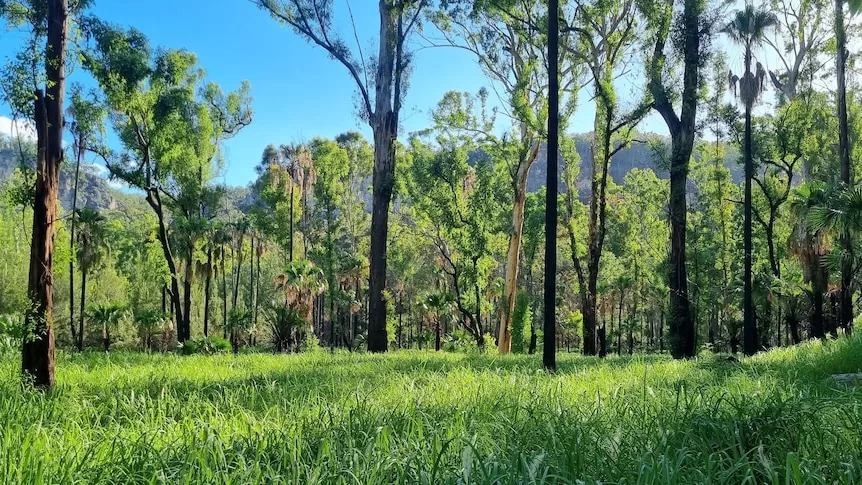Green shoots of life are bursting through the scorched undergrowth of a national park where a fast-burning bushfire tore through just months earlier.
While rain across Queensland has caused widespread damage in some areas, it has also helped restore Carnarvon National Park, in central Queensland.
The bushfire, which began in late August last year, burnt for about three months.
Of the roughly 344,000 hectares damaged, 167,000 of those were inside the park.
Some surrounding grazing land was also destroyed.
With the fire burning in difficult terrain for the most part, firefighters managed to get it under control after a change in weather, with rain finally extinguishing it by the end of November.
“After the fires, which were obviously very large and stressful for a lot of people, we had some fairly good rainfall,” ranger in charge of the Carnarvon Gorge section of the park, Lindie Pasma, said.
“The gorge floor is usually wetter than the rest of the areas, so that usually grows back well.
“But even the mid shelf country, which can be a lot bonier and drier, there’s plenty of regrowth happening up there as well.
“Everything’s fairly green and vibrant for us at this time.”
She said blade grass, which usually returned quickly after a fire, was a large part of the greenery coming through, as well as the eucalypts.
“We’re [also] seeing lots of little regrowth happening, all the little ground forbs and herbs are shooting up”, she said.
According to the Bureau of Meteorology, the Carnarvon region received 331 millimetres of rain in November and December.
About 110mm then fell in January.
Fire captured on trail cameras
Tour guide Simon Ling, who is researching a PhD on biodiversity monitoring with sound though the University of New England, lives near the park in Injune.
He had cameras and sound equipment stationed in various parts of the park which enabled him to document sections of the landscape before, during and after the fire.
Some of his trail cameras were destroyed in the fire but he managed to salvage some footage.
“The SD cards actually survived despite the units being rendered non-functional,” he said.
He said the return of greenery in some areas had been a rapid change.
“Kangaroo grass, barbed wire grass, they’re all doing very well, they’re flowered and have got seeds up again,” he said.
He said woody pear trees were also resprouting in areas, as well as the cycads, while the canopy layer was not too disturbed so did not have much recovery to do.
Tourism steady
The park is greening up but some trails remained closed.
They include the Carnarvon Great Walk, which closes every summer, to reopen at the end of February.
Wards Canyon will remain closed until the end of March after being damaged during flash flooding in December.
Queensland Parks and Wildlife said ancient rock art in the park was not damaged during the fire, thanks to fire management burns conducted previously throughout the year in several sections of the park.
But Mr Ling said it is too early to say what kind of tourism season he would see once it started in April, with current group bookings looking similar to last year.
“A lot of the main sites that you go and visit, those things are relatively unchanged by fire,” he said.
Farm recovery
Some cattle grazing areas burnt in the fire have also responded well, including section’s of Sid Godwin’s properties, which share a boundary with the park.
He said the first month after the fire was very dry but after that about 130 millimetres of rain fell in November before he received more in December and then 80mm in the past week.
“You couldn’t have ordered it any better, it was incredibly steady rain,” he said.
It took about three months for the pasture to fully come back, with Mr Godwin keeping cattle off recovering paddocks until recently.
“We’ve gone from as bad as you could imagine [to this], it really has impressed me and surprised me, we’ve been so fortunate with the rain.”
Get our local newsletter, delivered free each Friday
